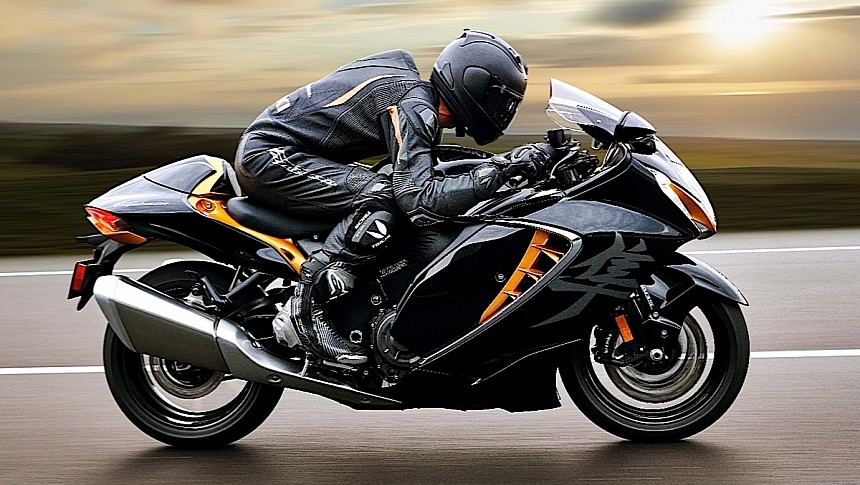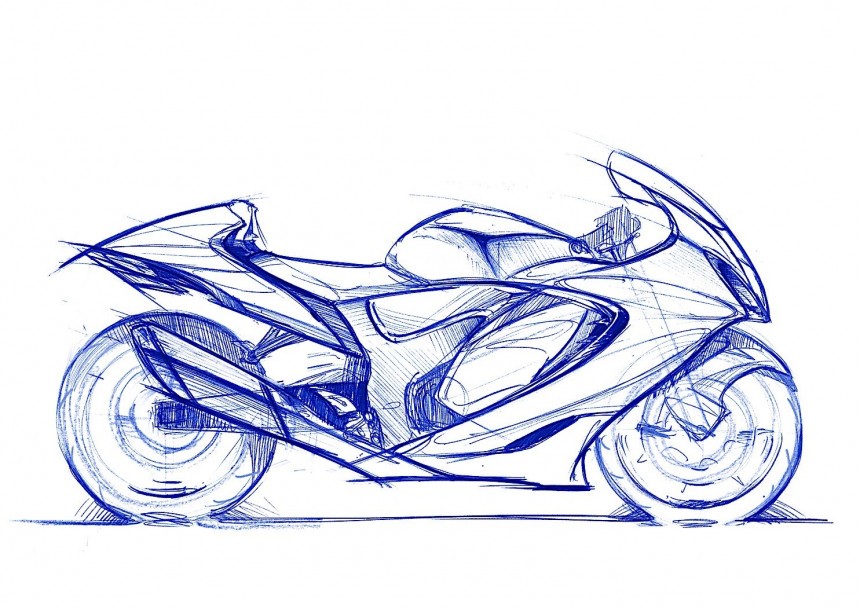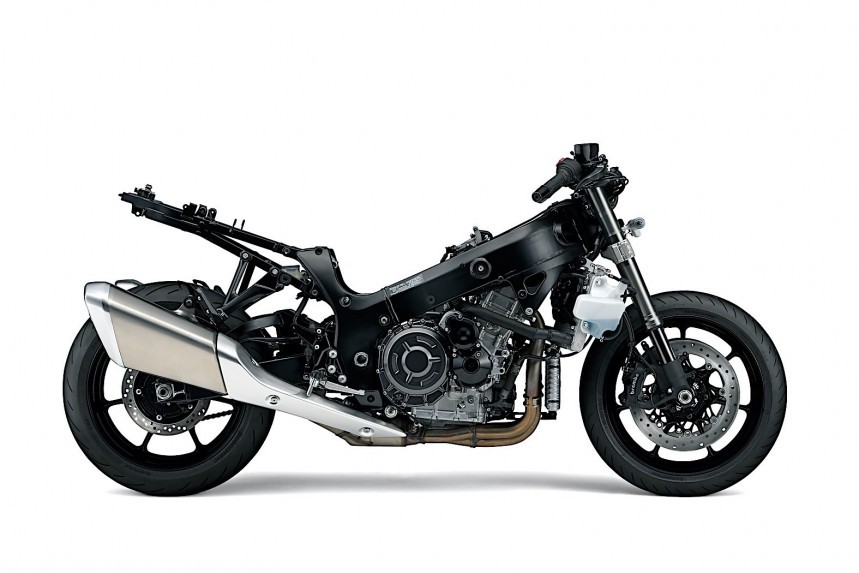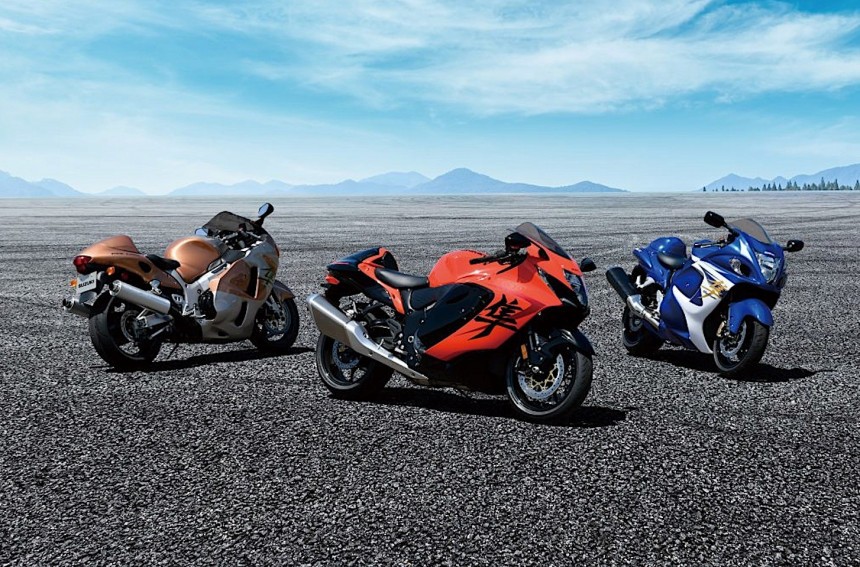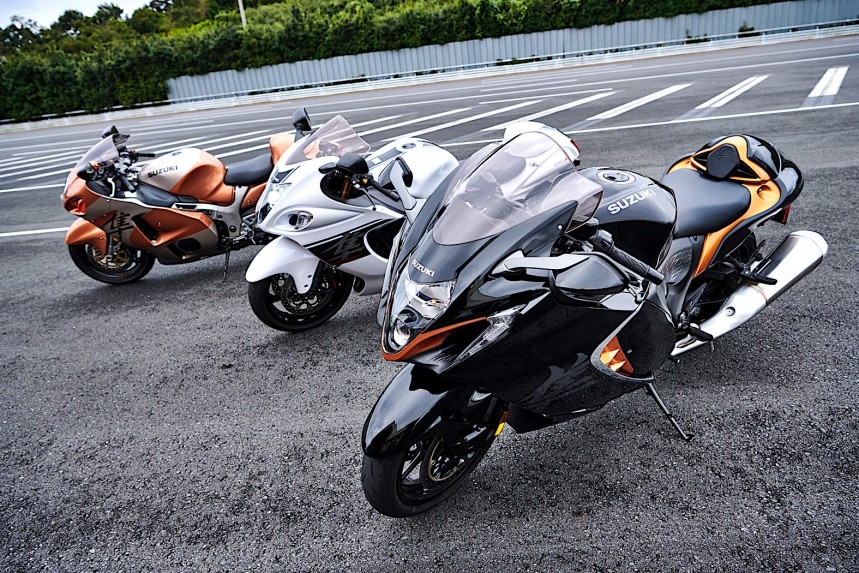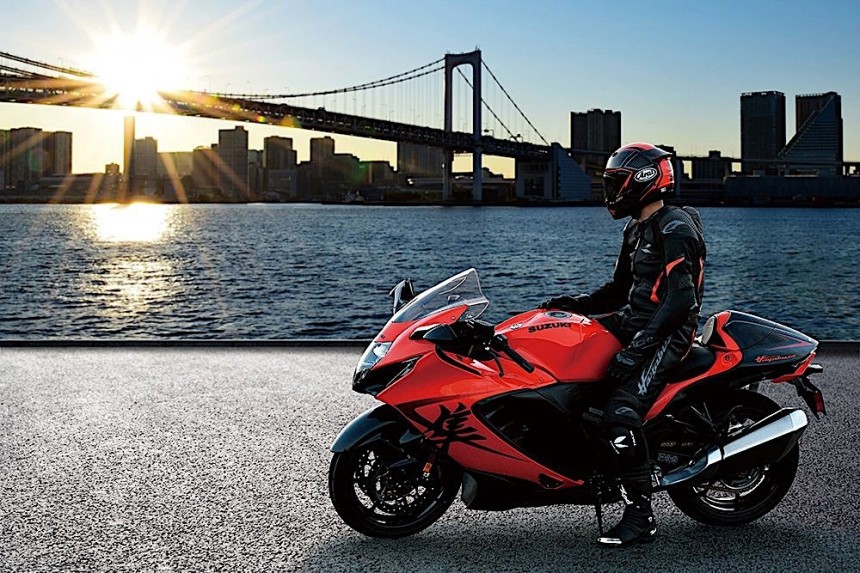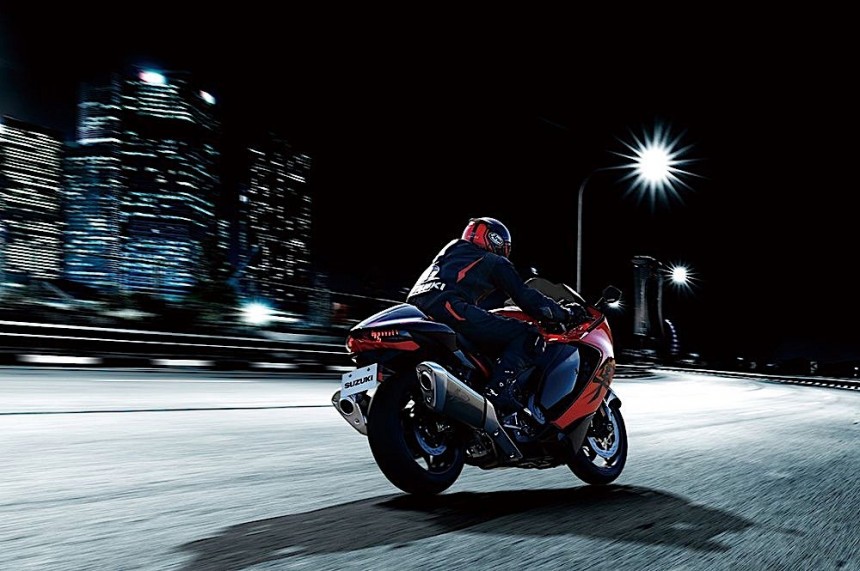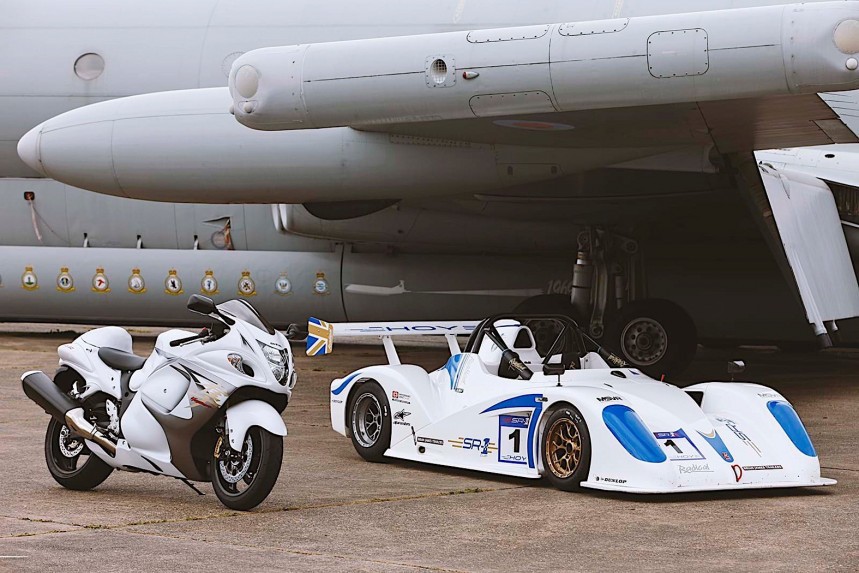Almost never in the history of man did a motorcycle so ugly manage to achieve so much as the Suzuki Hayabusa. Born with the single purpose of becoming the fastest two-wheeler on the planet, it rapidly did that, and then moved to even greater things. This is the story of the GSX1300R, the 'Busa, the peregrine falcon.
Japanese company Suzuki is one of the few businesses on the planet that makes both cars and motorcycles. It handles both quite successfully, but if you really look for something it excels at, we need not look further than its motorcycle lineup.
Much more diverse than the range of four-wheeled vehicles it offers, Suzuki's bike lineup includes not one model the world immediately recognizes as an icon, but several: Katana, Boulevard, V-Strom. And, of course, the king of them all, the mighty Hayabusa.
Being native to a country where motorcycling is a sort of art, Suzuki worked very hard to become the cult bike maker it is in some circles. And that status would have likely been greatly diminished if it weren't for a bike developed to take on one of Suzuki's main Japanese rivals.
Back in 1996, when the world was quiet enough to force people and companies into making noise to be noticed, Honda launched the CBR1100XX. Also known as the Super Blackbird, it was meant to challenge the supremacy of the Kawasaki Ninja ZX-11, at the time the world's fastest motorcycle. And challenge it did, as the Honda quickly snatched that title.
As any self-respecting Japanese company would do, Suzuki could not just stand by and let that pass unchallenged, so it started designing its own bike to bring the title home. And, in the hands of a guy named Koji Yoshiura, something grotesque and impossible to forget came to be.
The bike was designed like nothing else before it, with massive body panels wrapping all around the frame and engine in such a way it's like looking at an oversized kimono trying its best to hide a monster. It's an approach chosen to make the look of the bike perennial, but also to become the new face of Suzuki.
The bike was named Hayabusa because that's the Japanese word for peregrine falcon. In turn, that word was chosen for two perhaps equally important reasons. The first would be the fact that the carnivore bird feeds almost exclusively on other birds. Its diet is extremely varied, but one favorite dish is the… blackbird.
The second reason is the fact that the peregrine falcon is the fastest animal known to man. When in a high-speed dive, the beast can accelerate to a top speed of 200 mph (320 kph) – just think about it: that's faster than many of the cars on this planet are capable of going.
So, with Hayabusa Suzuki made no secret of the fact it is gunning not only to overthrow Honda's Blackbird, but also literally devour it. And that's exactly what it did.
It didn't take Suzuki long to end its work on the Hayabusa and let the world know there was a new leader in town. Three years after Honda launched the Blackbird, in 1999, Suzuki took press and employees to the Circuit de Catalunya in Spain to witness history.
It was not uncommon for high-profile motorcycles to be shown on the track, but what this bike managed to do then was unprecedented. It sped past the 177 mph (285 kph) mark set by the Honda Blackbird, entering the history books as the one that broke a speed record by the biggest margin.
The Hayabusa, wearing specially-developed tires made by Bridgestone, was ridden to a top speed of 193 mph (311 kph), no less than 10 mph (16 kph) more than its rival, officially becoming the fastest production bike on the market.
Quite the way for a legend to be born, but not nearly the end of what the bike was capable of. 12 years after the Hayabusa was introduced, in 2011, a rider by the name of Bill Warner rode the Japanese two-wheeler to a top speed of 311.945 mph (502.027 kph), at the time the world motorcycle land speed record.
Granted, that particular Hayabusa was not stock, but a highly modified one rocking turbochargers, but the achievement did nothing but cement the bike even further in the public consciousness as one no one should mess around with.
If you come to think about it, few other motorcycles managed to achieve so much in such a short period of time. Just consider that 1999 is just 24 years ago, and it usually takes a lot longer for something be rise to cult status.
Believe it or not, Hayabusa's 24-year life spans only three bike generations. The first one, the one which brought with it the record and a slap on Honda's face, ran from 1999 to 2007, and it was something unlike anything the world had even seen.
When it became the fastest production motorcycle in the world, and for the remainder of the first generation's days, the Hayabusa held in its frame a 1,299cc (79.3ci) liquid-cooled engine with four inline cylinders.
By all accounts, at the time that was the largest displacement for an engine in a sport bike, and it provided a record power output of 171 hp at the crankshaft.
Visually, the first Hayabusa was a blend of that grotesque image Yoshiura talked about and the looks that dominated everything around it. It certainly caught everyone's attention wherever it appeared – and it appeared in a lot of places, because despite the bike's insane performance, it has always been street-legal.
Like most other bikes out there, the Hayabusa spent a lot of years using the same mechanical bits, but occasionally refreshed with paint jobs and other not-so-important fittings. Then, in 2008, the second generation landed. And it was by no means just a mild refresh.
Many consider the second-gen 'Busa a major overhaul compared to what came before, and that first and foremost has to do with the fact it used a new engine. The already massive powerplant that helped beat Honda got even bigger, as it now displaced 1,340cc.
On top of that, it featured new internals, ran a revised transmission, and was now capable of broader torque across the rpm range. Horsepower increased as well, and the numbers the bike now bragged with stood at 196 hp and 155 Nm of torque. Visually though the bike didn't change much, as otherwise it would have probably lost its identity.
It was during this second generation that the Hayabusa was pushed out of one of its most important markets, the one in Europe, after tighter emission regulations came into force there.
Then just two short years ago, the third Suzuki Hayabusa landed. It too was a major departure from what came before it, with no less than 550 new parts, big and small, being included in the build. They all make for a list too long to discuss in detail, so we'll focus on the most important bits, especially given how this time there were more visual changes as well.
The front of the bike got vertically stacked LED headlights and new, more angular air intakes, while the rear was gifted with straight-edged exhaust and mufflers.
The twin-spar aluminum and engine are overall the same as on the previous generation, but the Japanese did install new pistons, camshaft, cam chain tensioner, crankshaft, crankcases, and even new gears.
An important thing to note is that, despite it being able to, the Hayabusa is no longer allowed to go faster than 299 kph (186 mph). An electronic limiter is taking care of that.
As you are reading this, the Japanese bike maker is celebrating the 25th anniversary of the Hayabusa. It even has a major event planned to take place at the In-N-Out Burger Finals at the NHRA Camping World Drag Racing Series.
The event will take place at the In-N-Out Burger Dragstrip in Pomona, California, on November 11. It's the perfect moment for anyone to enjoy and experience the mighty two-wheeler, including in the form of the 370 hp Turbo Hayabusa put together by Moore Mafia, and the Vance & Hines Hayabusa.
The gathering is however first and foremost dedicated to Hayabusa owners, who will get free grandstand entry, VIP parking, and even an In-N-Out Burger lunch voucher. For the first 200 riders to register, Suzuki is throwing in "an exclusive Hayabusa 25th Anniversary gift pack commemorating the famed sportbike."
The event should be a major one for all of the motorcycle's fans, but sadly many of them won't be able to enjoy it, not living in the States and all. For them Suzuki has something even more exciting up its sleeve: the Hayabusa 25th Anniversary model.
First presented in the summer of this year, the bike is basically the same stock Hayabusa enriched here and there with minor nips and tucks because, really, why mess with perfection?
The upgrades are mostly visual and they come as special decals placed on the sides, and the Hayabusa Kanji logo slapped over the drive chain. We still get the same shades of black, gray, white, and blue we're used to, only this time they are mixed with a lot more red, and even gold on the inner brake rotor and chain adjuster. The 25th-anniversary logo can be seen on the muffler.
The Suzuki Hayabusa in its 2023 model year incarnation is offered, aside from the 25th Anniversary model, in three color choices on the U.S. market. Riders can choose between Metallic Matte Black No. 2 & Glass Sparkle Black, Metallic Thunder Gray & Candy Daring Red, and Pearl Brilliant White & Pearl Vigor Blue.
For a bike of such impressive skill and potency, the Hayabusa can be described as anything but expensive. The Japanese are asking just $18,799 for one of them, no matter the color scheme. Pricing for the 25th Anniversary is not known for the U.S. at the time of writing, but in the UK it will sell from £18,599 ($22,600).
With so many things going for it, Suzuki is unlikely to let go of the Hayabusa anytime soon. From the company's business standpoint, the bike has been a hit, selling since its introduction some 200,000 examples. And that number is likely to climb even higher, given the current lineup and the fact the model sells in no less than 48 countries.
As far as riders go, some of them will probably be fans of the ride forever. I mean, it's not every day you come across a motorcycle that can be faster than many Lamborghinis, trashes all other bikes out there, and above all, it's also street legal.
You only have to look at the many drag races that star the motorcycle. And I don't necessarily mean the ones taking place at established drag strips, but also the impromptu or marketing-related ones.
Over the years, we've seen the 'Busa being pitted against the usual suspects on the tracks, the likes of Porsches and American muscle cars, and in many instances it definitely came out on top.
But just to get a sense of the league this bike plays in, consider the fact it is one of the very few two-wheelers to have raced, and even beaten, cars many of us never get to see once in their lifetime, let alone experience first hand.
Just go ahead and do a quick search for Suzuki Hayabusa here on autoevolution, and you'll be rewarded with stories of it going against exotics such as the Rimac Nevera, Koenigsegg Agera, and Lamborghini Aventador SVJ.
As far as I know, the Hayabusa has not been pitted yet against a fighter jet, and that's probably something the Japanese bike maker should consider, if it wants to keep its beast at the top of the food chain.
Especially given how five years ago, one of the bike's most important competitors, the Kawasaki Ninja H2R, was ridden to the win in a drag race that included a Challenger 605 private jet, an F-16 fighter jet, a Red Bull Formula 1, a Tesla Model S P100DL, a Lotus Evora GT430, and an Aston Martin Vantage.
A tough crowd to beat, but if the H2R did it, it should be a piece of cake for the Hayabusa. What say you, Suzuki?
Much more diverse than the range of four-wheeled vehicles it offers, Suzuki's bike lineup includes not one model the world immediately recognizes as an icon, but several: Katana, Boulevard, V-Strom. And, of course, the king of them all, the mighty Hayabusa.
Being native to a country where motorcycling is a sort of art, Suzuki worked very hard to become the cult bike maker it is in some circles. And that status would have likely been greatly diminished if it weren't for a bike developed to take on one of Suzuki's main Japanese rivals.
How the Suzuki Hayabusa was born
As any self-respecting Japanese company would do, Suzuki could not just stand by and let that pass unchallenged, so it started designing its own bike to bring the title home. And, in the hands of a guy named Koji Yoshiura, something grotesque and impossible to forget came to be.
The bike was designed like nothing else before it, with massive body panels wrapping all around the frame and engine in such a way it's like looking at an oversized kimono trying its best to hide a monster. It's an approach chosen to make the look of the bike perennial, but also to become the new face of Suzuki.
The bike was named Hayabusa because that's the Japanese word for peregrine falcon. In turn, that word was chosen for two perhaps equally important reasons. The first would be the fact that the carnivore bird feeds almost exclusively on other birds. Its diet is extremely varied, but one favorite dish is the… blackbird.
The second reason is the fact that the peregrine falcon is the fastest animal known to man. When in a high-speed dive, the beast can accelerate to a top speed of 200 mph (320 kph) – just think about it: that's faster than many of the cars on this planet are capable of going.
So, with Hayabusa Suzuki made no secret of the fact it is gunning not only to overthrow Honda's Blackbird, but also literally devour it. And that's exactly what it did.
The birth of a legend
It was not uncommon for high-profile motorcycles to be shown on the track, but what this bike managed to do then was unprecedented. It sped past the 177 mph (285 kph) mark set by the Honda Blackbird, entering the history books as the one that broke a speed record by the biggest margin.
The Hayabusa, wearing specially-developed tires made by Bridgestone, was ridden to a top speed of 193 mph (311 kph), no less than 10 mph (16 kph) more than its rival, officially becoming the fastest production bike on the market.
Quite the way for a legend to be born, but not nearly the end of what the bike was capable of. 12 years after the Hayabusa was introduced, in 2011, a rider by the name of Bill Warner rode the Japanese two-wheeler to a top speed of 311.945 mph (502.027 kph), at the time the world motorcycle land speed record.
Granted, that particular Hayabusa was not stock, but a highly modified one rocking turbochargers, but the achievement did nothing but cement the bike even further in the public consciousness as one no one should mess around with.
Suzuki Hayabusa generations
Believe it or not, Hayabusa's 24-year life spans only three bike generations. The first one, the one which brought with it the record and a slap on Honda's face, ran from 1999 to 2007, and it was something unlike anything the world had even seen.
When it became the fastest production motorcycle in the world, and for the remainder of the first generation's days, the Hayabusa held in its frame a 1,299cc (79.3ci) liquid-cooled engine with four inline cylinders.
By all accounts, at the time that was the largest displacement for an engine in a sport bike, and it provided a record power output of 171 hp at the crankshaft.
Visually, the first Hayabusa was a blend of that grotesque image Yoshiura talked about and the looks that dominated everything around it. It certainly caught everyone's attention wherever it appeared – and it appeared in a lot of places, because despite the bike's insane performance, it has always been street-legal.
Like most other bikes out there, the Hayabusa spent a lot of years using the same mechanical bits, but occasionally refreshed with paint jobs and other not-so-important fittings. Then, in 2008, the second generation landed. And it was by no means just a mild refresh.
Many consider the second-gen 'Busa a major overhaul compared to what came before, and that first and foremost has to do with the fact it used a new engine. The already massive powerplant that helped beat Honda got even bigger, as it now displaced 1,340cc.
It was during this second generation that the Hayabusa was pushed out of one of its most important markets, the one in Europe, after tighter emission regulations came into force there.
Then just two short years ago, the third Suzuki Hayabusa landed. It too was a major departure from what came before it, with no less than 550 new parts, big and small, being included in the build. They all make for a list too long to discuss in detail, so we'll focus on the most important bits, especially given how this time there were more visual changes as well.
The front of the bike got vertically stacked LED headlights and new, more angular air intakes, while the rear was gifted with straight-edged exhaust and mufflers.
The twin-spar aluminum and engine are overall the same as on the previous generation, but the Japanese did install new pistons, camshaft, cam chain tensioner, crankshaft, crankcases, and even new gears.
An important thing to note is that, despite it being able to, the Hayabusa is no longer allowed to go faster than 299 kph (186 mph). An electronic limiter is taking care of that.
Suzuki Hayabusa 25th Anniversary
The event will take place at the In-N-Out Burger Dragstrip in Pomona, California, on November 11. It's the perfect moment for anyone to enjoy and experience the mighty two-wheeler, including in the form of the 370 hp Turbo Hayabusa put together by Moore Mafia, and the Vance & Hines Hayabusa.
The gathering is however first and foremost dedicated to Hayabusa owners, who will get free grandstand entry, VIP parking, and even an In-N-Out Burger lunch voucher. For the first 200 riders to register, Suzuki is throwing in "an exclusive Hayabusa 25th Anniversary gift pack commemorating the famed sportbike."
The event should be a major one for all of the motorcycle's fans, but sadly many of them won't be able to enjoy it, not living in the States and all. For them Suzuki has something even more exciting up its sleeve: the Hayabusa 25th Anniversary model.
First presented in the summer of this year, the bike is basically the same stock Hayabusa enriched here and there with minor nips and tucks because, really, why mess with perfection?
The upgrades are mostly visual and they come as special decals placed on the sides, and the Hayabusa Kanji logo slapped over the drive chain. We still get the same shades of black, gray, white, and blue we're used to, only this time they are mixed with a lot more red, and even gold on the inner brake rotor and chain adjuster. The 25th-anniversary logo can be seen on the muffler.
Present-day lineup and outlook
For a bike of such impressive skill and potency, the Hayabusa can be described as anything but expensive. The Japanese are asking just $18,799 for one of them, no matter the color scheme. Pricing for the 25th Anniversary is not known for the U.S. at the time of writing, but in the UK it will sell from £18,599 ($22,600).
With so many things going for it, Suzuki is unlikely to let go of the Hayabusa anytime soon. From the company's business standpoint, the bike has been a hit, selling since its introduction some 200,000 examples. And that number is likely to climb even higher, given the current lineup and the fact the model sells in no less than 48 countries.
As far as riders go, some of them will probably be fans of the ride forever. I mean, it's not every day you come across a motorcycle that can be faster than many Lamborghinis, trashes all other bikes out there, and above all, it's also street legal.
You only have to look at the many drag races that star the motorcycle. And I don't necessarily mean the ones taking place at established drag strips, but also the impromptu or marketing-related ones.
Over the years, we've seen the 'Busa being pitted against the usual suspects on the tracks, the likes of Porsches and American muscle cars, and in many instances it definitely came out on top.
Just go ahead and do a quick search for Suzuki Hayabusa here on autoevolution, and you'll be rewarded with stories of it going against exotics such as the Rimac Nevera, Koenigsegg Agera, and Lamborghini Aventador SVJ.
As far as I know, the Hayabusa has not been pitted yet against a fighter jet, and that's probably something the Japanese bike maker should consider, if it wants to keep its beast at the top of the food chain.
Especially given how five years ago, one of the bike's most important competitors, the Kawasaki Ninja H2R, was ridden to the win in a drag race that included a Challenger 605 private jet, an F-16 fighter jet, a Red Bull Formula 1, a Tesla Model S P100DL, a Lotus Evora GT430, and an Aston Martin Vantage.
A tough crowd to beat, but if the H2R did it, it should be a piece of cake for the Hayabusa. What say you, Suzuki?
